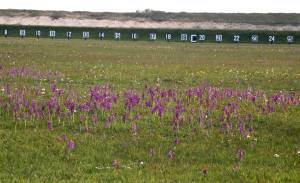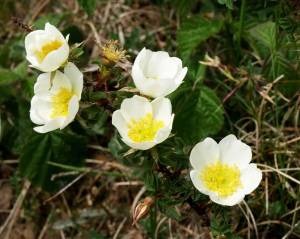Dr Phil Smith’s Wildlife Notes
May 2008
May is a wonderful month for wildlife, with fresh green vegetation, attractive flowers and insects everywhere. Although many birds are now nesting, migration for some is still in full swing and there is always the chance of a rarity. Last month, I bemoaned the fact that no Ring Ouzels had come my way. Not to worry, a phone call on 3rd May alerted me to a fine male on the Range High School playing fields. A few days later, while monitoring Natterjack Toads on Birkdale Green Beach, I bumped into a Snow Bunting – not really a rare bird, this uncommon winter visitor is certainly an exciting find for May. It stayed for several days, some superb photos being posted on John Dempsey’s Mersey Bird Blog.
Returning from a weekend away on 18th, I heard that a Red-backed Shrike had been found on North Moss Lane, only five minutes away. Luckily I managed to see it before dusk, as it had moved on by the following day. This colourful bird was a Lancashire breeder in the 19th century but our new “Birds of Lancashire & North Merseyside” tells us there have been only 13 modern records, the most recent in 1997.
Other notable May birds locally were an Osprey, two Spoonbills and a Roseate Tern at Seaforth, Golden Oriole, Pectoral Sandpiper and Temminck’s Stint at Martin Mere, while up to six Garganeys and the now resident Ribble Glossy Ibis graced Marshside. Meanwhile, the Altcar mosslands were briefly visited by a Dotterel and Common Crane.
Breeding species included Black-headed Gulls, 4560 nests being counted on Banks Marsh, while Avocets peaked at 23 pairs at Martin Mere and 32 at Marshside. Many of the latter relayed after 17 nests were predated by a Red Fox. Marshside also had displaying Ruff. On 6th May, I watched three exotically plumed males performing to the same number of females. Whether they bred nearby has yet to be confirmed.

On the sand-dunes, I counted a record number of 218 Natterjack Toad spawn strings on Birkdale Green Beach, while guided visitors to Altcar Rifle Range were thrilled by thousands of gorgeous Green-winged Orchids.
Hightown dunes put on its usual display of the scented Burnet Rose, a speciality of that area.

While checking a colony of the nationally rare Vernal Bee at Cabin Hill on 11th May, my attention was drawn to a tiny rufous bee flying in and out of a snail shell. I sent a blurred photo to my old friend Neil Robinson, an expert in this group of insects. He identified it as a mason bee called Osmia aurulenta which is well known for rearing its brood in empty snail shells. Coincidentally, it was featured last year in Alan Titchmarsh’s “Nature of Britain” TV series.
Spells of cool weather meant dragonflies were slow to appear but, by the end of the month, I had seen seven species hereabouts, including three Broad-bodied Chasers, a spectacular insect that is moving north with climate change and which has only recently become established in our area.
